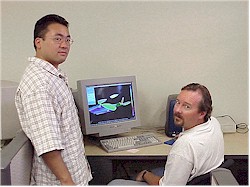 |
AeroHydro,
Inc.
Relational 3D Modeling for Marine & Industrial Design
|
| Marine
design MultiSurf Gallery Users Hydro Flattener Suite AHVPP Industrial design
|
Navatek Ships Navatek Ships, a subsidiary of Pacific Marine & Supply Co.,
Ltd., in Honolulu, is a world leader in the design and construction of high-tech ships,
particularly SWATH (Small Waterplane Area Twin Hull) vessels and their faster and more
fuel-efficient Slice and Midfoil variants. Their recent development cycles have been
remarkably speeded by addition of MultiSurf to their suite of design and analysis software
tools. Navatek Ships, a subsidiary of Pacific Marine & Supply Co.,
Ltd., in Honolulu, is a world leader in the design and construction of high-tech ships,
particularly SWATH (Small Waterplane Area Twin Hull) vessels and their faster and more
fuel-efficient Slice and Midfoil variants. Their recent development cycles have been
remarkably speeded by addition of MultiSurf to their suite of design and analysis software
tools.
Slice
Midfoil Low waterplane area ships, while widely acknowledged to have superior motions to other buoyant support concepts, historically have been limited in speed/power performance. Hydrofoils, on the other hand, have excellent speed/power performance, but generally only at one speed, or at a narrow band of speeds. This is an inevitable consequence of the fact that hydrofoil lift forces vary as the square of vessel speed. Producing a hydrofoil with a wide band of operable speeds would require that it be able to operate at a wide range of lift coefficients.
To date, the Midfoil appears to be a "best combination" of low waterplane and hydrofoil technologies. It uses a submerged foil for low-drag support, but as a displacement lift rather than as a dynamic lift. Since the vessel is a displacement ship, there is no pronounced "speed band" as with a hydrofoil. This results in a vessel with excellent performance at all speeds, as well as excellent motions at all speeds. Midfoil promises significant improvements over other existing hull forms in respect to resistance (offering less wetted surface area, less wave-making drag, and less appendage drag), improved seakeeping, propulsive efficiency, hydrostatic and hydrodynamic stability, and higher transport efficiency. MultiSurf Integrated into the Design Cycle The original SWATHs, as well as the Slice and Midfoil, were designed before Navatek acquired MultiSurf, but Scott Lawrey, naval architect with Navatek, has since created complete models of them using the software. Navatek also has on-going projects for building new foils with MultiSurf. Scott describes the general, integrated process for one of these foils: "The 2D section shape was designed in X-foil on an SGI. The text file of the offsets was then run in a small program I wrote, which expands it into 3D in a given plan shape and span distribution and outputs a MultiSurf .ms2 file. In MultiSurf, the foil was scaled to the appropriate size, hydrostatics were checked, struts were added, SubSurfs and Relabels were tweaked to get the appropriate meshing distribution for output to VSAERO CFD. Other components of the vessel were brought into MultiSurf, as necessary, and then everything was output as patch files (.pat). I have another utility program that then took these patch files and formatted them for VSAERO input. The CFD was run, results were checked, the model was tweaked, the CFD was run again, the model was tweaked, the CFD was run... When everything looked good, MultiSurf ship lines were output to GHS to check the stability. Before MultiSurf, we averaged one new shape submitted to CFD a week. Now we sometimes have 5 variations running every day! And that's only because we've only got 5 licenses of VSAERO." Accuracy "We were very concerned," adds Scott, "about the overall finished fairness and accuracy because of the extreme compound curvature of the foil combined with some large, near-flat areas that are always the hardest to get fair. We used MultiSurf to lay out some diagonals and other cuts on the molded surface and had those printed to Mylar as well. After they were transferred to templates, we laid them on the finished foil and largest gap we had was less than 1/32" over a 25 ft length!!!!" Tenfold Increase in Productivity "Needless to say," concludes Scott, "we are very happy with MultiSurf. Probably the most important parts of MultiSurf that have allowed us to increase our productivity tenfold are the ability to relabel the meshing and output it as patch files, and the fact that the .ms2 files are text files, which allows us to use Visual Basic integration between MultiSurf and our other software tools. These components have allowed us to automate a lot of the model building." And we at AeroHydro are very happy to hear from well-satisfied and successful customers such as Navatek Ships. Their work is what keeps us going. We wish them the best for continued design innovation. Navatek Ships |



